Note: This is Part II in a three-part series on Fast Followers. Click here for Part I and Part III
When Superman was introduced in 1939, he was truly a breakthrough comic book character. At the time, most comic heroes were very human, such as Dick Tracy, The Lone Ranger and Tarzan. The very attributes which caused Superman to be unlike anything that came before subsequently became clichéd conventions, which makes it difficult for modern audiences to appreciate just how startlingly different Superman was at the time of his debut. 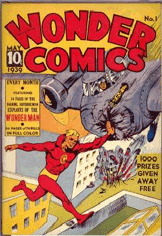 His super powers, costume, dual identity and crime-fighting focus have been endlessly imitated, sometimes a bit too closely.
His super powers, costume, dual identity and crime-fighting focus have been endlessly imitated, sometimes a bit too closely.
Within months of Superman’s first appearance, Fox Features Syndicate created Wonder Comics, starring “Wonder Man.” As shown at left, he had super powers, wore a red uniform, fought crime and had a large “W” on his chest. Sound familiar? The public rejected this dismal imitation and the comic sold poorly.
Copies which lack originality are similar to those successively made on a Xerox machine. Each copy is an inferior imitation of that upon which it is based.
If you haven't already subscribed yet, subscribe now for
free weekly Infochachkie articles!
Subtle Innovations
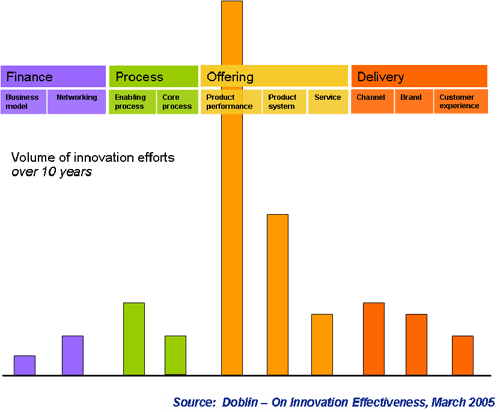
Innovation is commonly associated with either the introduction of new products or new features added to existing products. Such innovations are often focused on making products stronger, faster, smaller, lighter and cheaper. The relative dominance of product-oriented innovations is clearly depicted in the graph at above.
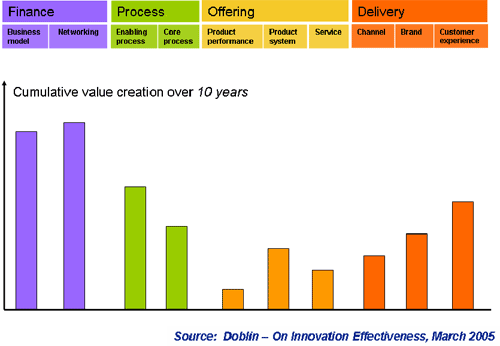 However, Doblin points out in On Innovation Effectiveness, such product innovations are often the least financially rewarding. As shown in Doblin’s second graph, improvements related to customer service, product delivery and company infrastructures historically deliver higher rates of return than product performance innovations. Let The Herd focus on such mundane innovations while you seek enhancements that are less obvious and more financially rewarding.
However, Doblin points out in On Innovation Effectiveness, such product innovations are often the least financially rewarding. As shown in Doblin’s second graph, improvements related to customer service, product delivery and company infrastructures historically deliver higher rates of return than product performance innovations. Let The Herd focus on such mundane innovations while you seek enhancements that are less obvious and more financially rewarding.
Slow Follower – GoToMyPC Vs. pcAnywhere
“We had the 32nd mover advantage”
– Scott Cook - Founder of Intuit, describing the state of the market upon Quicken’s release
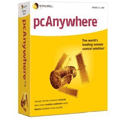 Released in 1986, pcAnywhere was the dominant remote access software solution in 2001. In fact, in an August 1999 press release titled, "pcAnywhere 9.0 Distinguished as Analysts Choice,” Symantec claimed a market share equal to, “76 percent of the retail remote control market according to PC Data's retail share report -- and 85 percent of the corporate market,” in an otherwise fractional market. Like most legacy software solutions, pcAnywhere had become bloated with features that most users never became aware of, let alone used.
Released in 1986, pcAnywhere was the dominant remote access software solution in 2001. In fact, in an August 1999 press release titled, "pcAnywhere 9.0 Distinguished as Analysts Choice,” Symantec claimed a market share equal to, “76 percent of the retail remote control market according to PC Data's retail share report -- and 85 percent of the corporate market,” in an otherwise fractional market. Like most legacy software solutions, pcAnywhere had become bloated with features that most users never became aware of, let alone used.
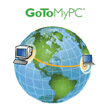 Despite the excess of pcAnywhere’s features, the primary value proposition of GoToMyPC and pcAnywhere was the same – remote access to a geographically distant computer. One of GoToMyPC’s distinct points of differentiation was that users could download it via the Internet, use if free for 30 days and then decide if they wanted to keep it. In contrast, in order to “test drive” pcAnywhere, users had to purchase the software at a retail location and then deal with a rather cumbersome, manual installation process on two PCs. If a user was not satisfied with the product, they were forced to return it to the retail location, subject to that particular store’s return policy.
Despite the excess of pcAnywhere’s features, the primary value proposition of GoToMyPC and pcAnywhere was the same – remote access to a geographically distant computer. One of GoToMyPC’s distinct points of differentiation was that users could download it via the Internet, use if free for 30 days and then decide if they wanted to keep it. In contrast, in order to “test drive” pcAnywhere, users had to purchase the software at a retail location and then deal with a rather cumbersome, manual installation process on two PCs. If a user was not satisfied with the product, they were forced to return it to the retail location, subject to that particular store’s return policy.
In addition, GoToMyPC required no technical knowledge. Even the most unsophisticated user could access their PC remotely in a matter of minutes, without the intervention or assistance of someone with technical savvy. In fact, GoToMyPC’s tagline, “Fast, Easy, Secure,” was derived from the fact that these attributes were noticeably absent from Symantec’s solution.
Thirdly, GoToMyPC also allowed users to access a PC from any Internet connection. In contrast, the ironically named pcAnywhere limited users to a single computer from which they could access their remote desktop. In this respect, pcAnywhere was akin to a telephone that allowed you to call a single phone number. Even in 2009, pcAnywere’s marketing materials note that it only offers users a “one-to-one” connection, as opposed to GoToMyPC’s “anywhere-to-one” capabilities.
These differentiating factors – ease of delivery, ease of use and “anywhere-to-one” accessibility – allowed GoToMyPC to destroy pcAnywhere’s market leadership position.
Serving An Empty Box
There were two significant challenges we faced when we launched GoToMyPC. One was properly setting the market’s expectations. The second related to educating the market as to the power and benefit of software as a service (SaaS). At the time we launched GoToMyPC in January 2001, companies that delivered SaaS were called “application service providers” (ASPs). There was a significant lack of understanding and mistrust of ASP solutions among most Big Dumb Companies (BDCs). Numerous BDC executives derisively told me, “We will never allow software to be delivered through our firewall! If the software is not installed on one of our servers, we will never buy it.” Three BDCs that will remain nameless – … OK, Microsoft, Siebel and Oracle – all took this position, which is ironic as each of these companies later launched ASP initiatives.
Our technical team took an adamant position with respect to dealing with the market’s resistance to ASP solutions. We were unwilling to place any portion of our technology behind our customers’ firewalls. By refusing to compromise our ASP status for anyone, including Siebel, Microsoft or Oracle, we materially slowed the adoption of our technology. On technical grounds, the decision was reasonable. SaaS products are easier to develop, maintain and update, as compared to server-based software solutions. However, from a sales and marketing standpoint, our recalcitrant approach toward our prospects’ concerns was problematic.
WebEx, with whom we competed on a peripheral basis with our GoToAssist support product, took a clever, market-centric approach to customers’ distrust of ASP solutions. Rather than balking at customers’ requests to “put a server behind my firewall,” they did just that. They placed a “dumb” server that did little more than turn off and on, behind customers’ firewalls. The big red OFF button on WebEx’s servers allowed customers to feel that they were “in control” and in compliance with their BDC’s edict to avoid ASP solutions. Although simplistic, this customer-focused strategy garnered WebEx significant market penetration.
Despite the tremendous education required to acquaint users to the benefits of ASP solutions, we were able to “draft” the pcAnywhere multi-decade marketing efforts which espoused the benefits of remote access. This key fast-follower strategy is described further in Competitive Sleuthing.
GoTo My MVP
Greg Alwang, a contributing editor at PC Magazine, was a beta user of GoToMyPC who loved the product. We worked closely with Mr. Alwang, as well as other Media Messengers, to ensure that our Minimally Viable Product (MVP), which was relatively rudimentary, was not maligned for its lack of features.
 Our MVP version of GoToMyPC was the cherry on top of the banana split. It offered users the feature with the highest utility, namely – fast and easy remote access. We knew that if we successfully sold the “cherry,” we could later add different flavors of ice cream, whip cream, various types of sauces, nuts, etc.
Our MVP version of GoToMyPC was the cherry on top of the banana split. It offered users the feature with the highest utility, namely – fast and easy remote access. We knew that if we successfully sold the “cherry,” we could later add different flavors of ice cream, whip cream, various types of sauces, nuts, etc.
In March 2001, in conjunction with our commercial launch, Mr. Alwang wrote a glowing review of GoToMyPC, which confirmed that we had done an excellent job of proper positioning. Although he noted that our file transfer features were “basic compared with pcAnywhere,” he highlighted the ease of use and from-many-to-one differentiating aspects of our solution. We used the concluding sentence of his review in our marketing materials for several years: “GoToMyPC is revolutionary, and pcAnywhere is evolutionary.”
In July 2008, Citrix announced that GoToMyPC sales accounted for 90% share of the remote access market, while growing at an annual rate of 20%. In 2009, Symantec continued to promote pcAnywhere as, “the number one best-selling remote control solution”. However, the fine print justifying this puffery is based upon “the NPD Group/Retail Tracking Service.” Maybe it is time for pcAnywhere to update its analysis to include online sales of remote access solutions, which dwarf its legacy retail channel. Its claim is similar to identifying a particular brand of milk as, “the number-one best-selling” based on door-to-door milkman deliveries. Symantec should fess up and admit it lost its leadership position to GoToMyPC many moons ago.
Fast Follower – GoToMeeting Vs. WebEx
![]() As noted in Fast Follower I, successful fast followers devise products which embody the critical features most valued in legacy solutions, while enhancing their offerings with one or more memorable, highly salient and unique features.
As noted in Fast Follower I, successful fast followers devise products which embody the critical features most valued in legacy solutions, while enhancing their offerings with one or more memorable, highly salient and unique features.
 When we revised our business model from the “marketplace for expert services” to a SaaS solution, we repositioned our remote access core competency as a technical support solution called GoToAssist. This focus on the support market allowed us to avoid head-to-head competition with WebEx. Our strategy was sound, as there were plenty of green-field opportunities for both companies to pursue, without battling each other. However, once GoToMyPC was successful, we placed our sights on the online collaboration market, which forced us to directly compete with WebEx, the undisputed market leader.
When we revised our business model from the “marketplace for expert services” to a SaaS solution, we repositioned our remote access core competency as a technical support solution called GoToAssist. This focus on the support market allowed us to avoid head-to-head competition with WebEx. Our strategy was sound, as there were plenty of green-field opportunities for both companies to pursue, without battling each other. However, once GoToMyPC was successful, we placed our sights on the online collaboration market, which forced us to directly compete with WebEx, the undisputed market leader.
As described in Fast Follower I, we gave our elephant vibrant pink sunglasses, in an attempt to avoid a “Coke versus Pepsi” battle. GoToMeeting’s differentiating characteristics were identified and evaluated via a rigorous, iterative product validation process, which entailed:
Meet – We met with numerous current and former WebEx customers as well as individuals who had never used a collaboration product
Discuss – We discussed their likes, dislikes and concerns
Propose – We then proposed a variety of differentiating characteristics and asked them to prioritize a list of proposed features
Evaluate – We then evaluated the respondents’ feedback
These steps were repeated a number of times until we finally honed the characteristics of our MVP, which balanced ease of use with the features users had identified as having the highest utility.
Throughout this process, we heeded Doblin’s advice and focused on non-product-centric innovations. After thousands of surveys and hundreds of interviews, we identified the following four innovations, which enabled us to attract both customers who had not previously purchased an online collaboration solution, and current and previous WebEx users to purchase GoToMeeting:
Self-serve – Current and former WebEx customers were frustrated that the product required significant technical expertise, especially with respect to setting up large meetings. GoToMeeting allowed users with little to no technical capabilities to set up a web meeting without involving their technical team. This was especially important, as our analysis showed that a significant percentage of web meetings involved little to no planning and thus, we knew that a solution that could be deployed spontaneously would have broad applicability.
Easy to Use – Although still a relatively young company, WebEx had become a victim of the Innovator’s Dilemma by the time GoToMeeting was released. With each development cycle, WebEx added additional features. Similar to pcAnywhere, WebEx’s solution was so feature-rich that it was not easy to use. Our research indicated that most users wanted to simply display their screen to a few people at a time and that WebEx’s more esoteric features were seldom used. As such, our GoToMeeting MVP did little more than allow a user to simply and easily share their PC screen with a small, remote audience.
All You Can Meet Pricing – In our customer discussions, it quickly became clear that there was significant dissatisfaction with WebEx’s pricing model, which included a substantial setup charge (averaging $4,000) and required meeting organizers to pay an incremental fee for each meeting attendee. There were also bandwidth charges, based on the length of each meeting. For instance, WebEx charged $54 for a 60-minute meeting with one attendee. This pricing strategy, which is analogous to pricing plans in the early days of cell phones, discouraged usage, as customers were reticent to host web meetings unless they could “justify” the expense. It also wreaked havoc with users’ budgets, as they could not accurately predict their monthly WebEx expenditures.
We addressed the market’s pricing concerns by instituting a flat monthly fee that allowed users to hold an unlimited number of meetings, irrespective of the number of participants (within reason – a de facto limit was implemented to preclude usage of GoToMeeting as a webinar solution). When presented with this proposed pricing paradigm, one survey respondent declared, “That is ‘all you can meet’ pricing.” We liked phrase “All you can meet” so much that it became GoToMeeting’s tagline. Customer reaction to our pricing model was so strong that WebEx eventually copied it – a case of the followed becoming the follower.
Online Distribution – WebEx had invested in an expensive, direct sales force and had not developed the in-house expertise required to sell products online. This lack of online sales and marketing acumen led to the failure of its me-too GoToMyPC alternative, PCNow. By offering our collaboration solution online, we were able to reach a much larger audience than was addressable by WebEx’s direct sales team, while maintaining lower overhead costs, which supported our aggressive, flat-fee pricing strategy.
Follow Yourself And Take The Lead
The punch line of Clay Christensen’s highly influential book, The Innovator’s Dilemma, is <spoiler alert> “you must eat your own lunch before someone else does.” DC Comics put Christensen’s self-evident sentiment into effect decades before Clay was born.
Despite the fact that Superman was an immediate success, no comic publisher was able to devise a similarly successful character. In fact, some pundits declared that Superman was a “fluke” and that the public’s appetite for such costumed heroes was limited.
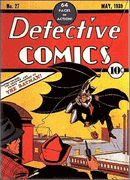 DC Comics, Superman’s publisher, did not agree. Understanding that simple replication is seldom an adequate fast-follower strategy, DC Comics did not attempt to recreate Superman’s success with derivative incarnations. Instead, it innovated on Superman’s formula.
DC Comics, Superman’s publisher, did not agree. Understanding that simple replication is seldom an adequate fast-follower strategy, DC Comics did not attempt to recreate Superman’s success with derivative incarnations. Instead, it innovated on Superman’s formula.
DC Comics repurposed some key aspects of Superman’s persona, such as his costume, dual identity and crime-fighting preoccupation, and melded them with some of the pre-Superman heroes’ characteristics, including deductive reasoning, acrobatic skill and physical prowess. The result was the second comic book “hit” – Batman.
This is Part 2 of the three part series on Fast Followers. The first part Fast Followers I is here, and the third part will be posted next week.
______________________
John Greathouse has held a number of senior executive positions with successful startups during the past fifteen years, spearheading transactions which generated more than $350 million of shareholder value, including an IPO and a multi-hundred-million-dollar acquisition.
John is a CPA and holds an M.B.A. from the Wharton School. He is a member of the University of California at Santa Barbara’s Faculty where he teaches several entrepreneurial courses. He is also the author of an award-winning entrepreneurial blog infoChachkie.com. You can learn more about his experiences at johngreathouse.com
______________________
<
Copyright © 2007-9 by J. Meredith Publishing. All rights reserved.




Pingback: Fast Follower III – First Mover Disadvantage | infoChachkie
Pingback: Quora
Pingback: Entrepreneurs Should Go For The Quick Buck – Then Stop
Pingback: Startups Are A Remix
Pingback: A Serial Entrepreneur’s Guide To Uncovering Awesome Startup Ideas
Pingback: Nine Startup Tips From Michael Dell | infoChachkie